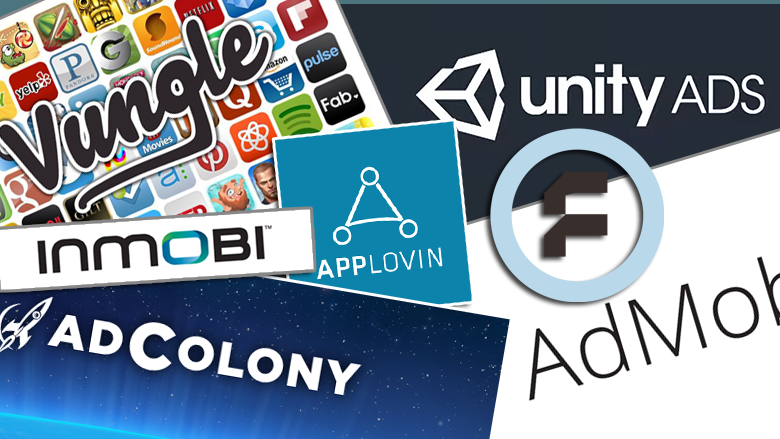SOOMLA: top 10 advertising grids of 2016
The Israeli SOOMLA team has published a blog list of the most popular advertising grids for the beginning of 2016. Here are 10 of them – in descending order of popularity.
Formats: fullscreen ads, native ads, TrueView video ads, banners, lightboxes, video ads
AdMob is one of the most popular advertising networks. Google acquired the grid in 2009 and made a number of changes to it.
Pros: the grid makes it possible to measure the level of audience coverage (fill rate), demonstrates high eCPM and supports cross-platform monetization for Android, iOS and Windows 8 (there is no support for Windows 10 yet).
Cons: you need to register in AdSense, there are restrictions on the number of ads (no more than one ad per page).
Formats: rewarded and non-rewarded video advertising, banners, fullscreen advertising
Formerly known as the Applicier, Unity Ads is also a very popular advertising grid. Allows you to monetize games on Unity using native advertising. In other words, if a developer uses the Unity engine to create a game, then you will not have to integrate the SDK additionally.
Pros: there is no need to integrate the SDK into the game, there are many supported formats.
Cons: relatively low level of audience coverage (according to SOOMLA, the lowest values reach 35-40%).
Formats: fullscreen advertising, video advertising, native advertising
One of the most popular grids among mobile developers. Specializes in cross-advertising solutions – that is, it allows developers to directly sell each other advertising space in games. Some developers claim that they have earned more money with Chartboost than with all the other grids combined.
Pros: it gives access to a large amount of various analytical data – for example, it allows you to view the number of installations and impressions, as well as earnings from each project. Supports both iOS and Android. Using the Smartbid service, grid users can track the sources of third-party (relative to Chartboost) CPI traffic.
Cons: Many developers in this grid are far from Supercell. Advertising in the title will cost a penny – but it will also bring a little.
Formats: video advertising, native advertising, fullscreen advertising, banners
Another grid with access to detailed analytics. Allows you to track the level of audience coverage and eCPM in different countries. Pays income fixed as a salary – on the 15th of each month.
Pros: the minimum payment for access to the grid is $20.
Formats: video advertising
One of the main advantages of this grid is the recently launched Premium service. Here advertisers will be able to choose the application or game with the most successful indicators and place their ads there.
Separately, it should be noted that Vungle has an SDK for Windows 10.
Pros: there is a private studio Vungle Creative Labs, which makes advertising to order.
Cons: Some users complain about low incomes.
Formats: fullscreen advertising, video advertising, native advertising
Grid for developers on Android. The key feature is AppWalls. This is a full-screen ad that does not completely cover the screen, but “appears directly in the application without transitions“.
Positive: some mobile developers praise the grid because of the minimal data load.
Cons: there are reviews that the place with mobileCore does not put another advertising grid, as this will lead to application crashes.
Formats: video advertising
AdColony is a mobile video advertising grid.
Pros: Delivers pre-roll videos in high resolution. And regardless of the quality of the Internet or the device.
Cons: according to reviews, it forces users to watch 30-second videos. Pays little.
Formats: rewarded advertising with a choice of remuneration (offerwall), banners, video advertising, fullscreen advertising
The grid, whose services are used by large companies, including EA, Hasbro and Disney.
Cons: developers consider customer service to be the main problem of the grid. Which is not surprising, considering that the grid has half a billion users.
Formats: rewarded advertising with a choice of remuneration (offerwall), video advertising, fullscreen advertising
Fyber was founded in Berlin in 2009, and was then called SponsorPay.
Pros: one of the main features is Auto Pilot. Allows you to “automatically optimize sources of advertising revenue.” In other words, it saves the developer from having to independently set the priority in displaying ads from the advertising grid. The platform copes with this task by itself.
Cons: there are problems with customer service.
Formats: native ads, fullscreen ads, banners, videos
According to SOOMLA, InMobi is one of the largest advertising platforms in the world. Offers customers “visibility zones” (discovery zones). By the definition of the company itself, these are “the ways in which users receive content in applications.” Moreover, this content is strictly moderated by the grid itself. It is not completely clear what “visibility zones” are. But the approach seems to be working: the grid has 800 million unics from 200 countries.
Let’s add that SOOMLA received data on the popularity of grids using its own technology called Mixrank, which allows you to determine which SDK is in the application. In addition, the company used data from its own GROW network.
A source: http://blog.soom.la
You can learn about the latest trends in the gaming industry first-hand, meet personally and discuss working issues with leading companies in the game development and publishing market at White Nights Helsinki 2016, which will be held on February 11-12.
